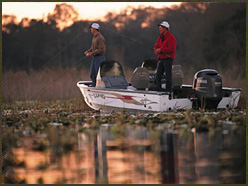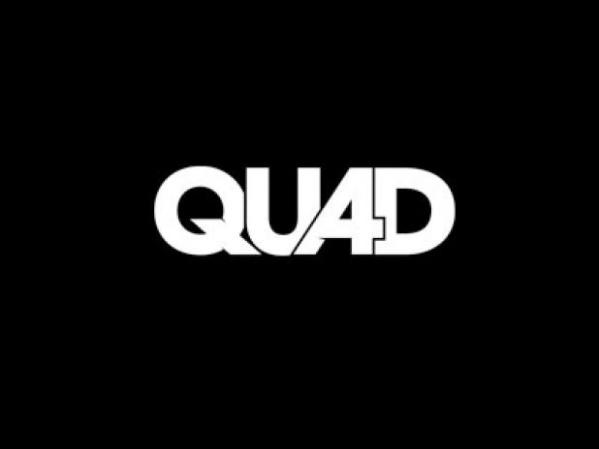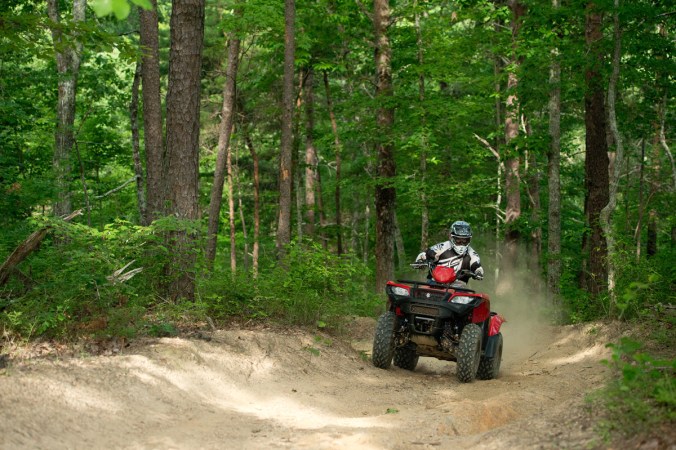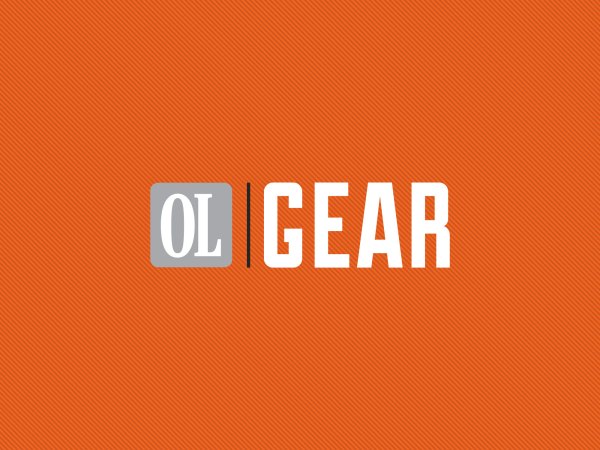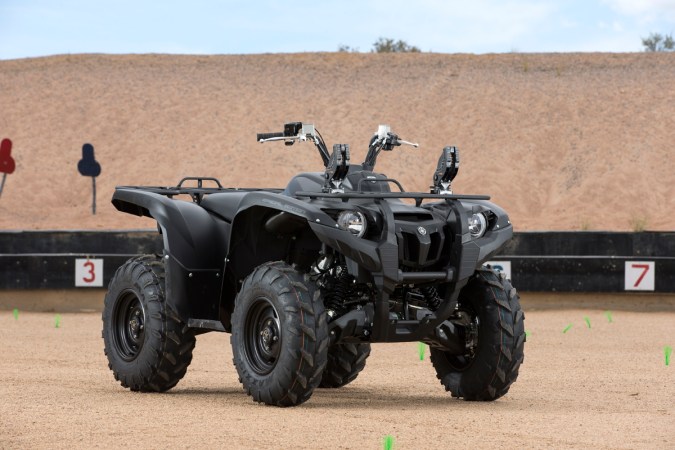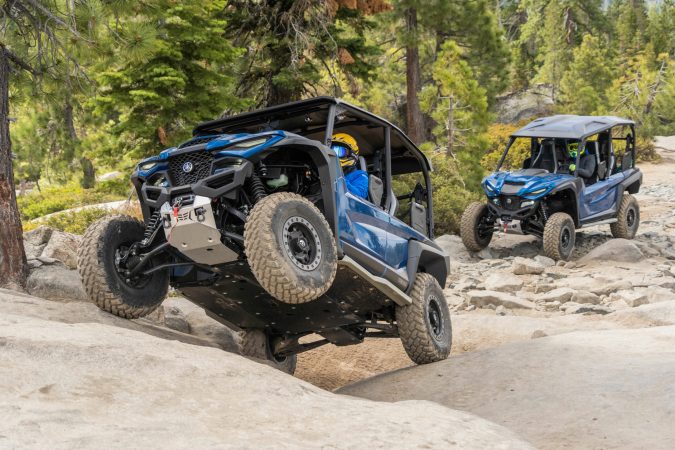We may earn revenue from the products available on this page and participate in affiliate programs. Learn More ›
The 2004 outboard crop has cut through the blue haze that used to envelop most marinas at sunrise. Thanks to four-stroke engines and direct-fuel- injection (dfi) motors, which burn a fraction of the oil of earlier kickers, the fog of oil smoke is gone-and so is the pollution.
But the best news is fuel economy. Considering the price of gasoline lately, how would you feel about cutting your fuel bills in half? Many of these new motors can do that. Most of them also run quieter and have fewer mechanical problems than the outboards that preceded them. The bad news is that you’ll pay more for the new outboards, which rely heavily on production-intense four-cycles or complex high-pressure, direct- injection two-strokes. For those who run their motors hard, however, the savings in fuel will make up for the added cost quickly.
Here’s a look at some of the more interesting motors now at your dealer.
Evinrude
The Evinrude E-TEC series, Bombardier’s revised edition of dfi two-strokes, is available in 40-, 50-, 60-, 75- and 90-horse versions. The company says the new system runs even cleaner than the FICHT motors that have been OMC’s primary approach to meeting new pollution standards and that the motors are lighter and require less maintenance due to the elimination of mechanical oil pumps, powerhead gears and belts. The motors have no dealer-scheduled maintenance for three years, a big boost in on-the-water time if they perform as advertised.
They’re exceptionally quiet for a dfi-type two-stroke, thanks to a double cowl, foam insulation in both upper and lower covers and a new piston design that reduces “slap” in the cylinders. Many dfi motors have an unpleasant whine at idle, but the E-TECs seem to be nicely muffled. Is silence that important to you? It is if you’re an all-day troller who doesn’t want to yell over the outboard. There’s some evidence that noisy motors put off fish for trollers, too, particularly in shallow water, so silence is definitely golden.
The key to improved efficiency on the E-TECs is a next-generation fuel system that injects the charge in half the time of some other dfi systems, eliminating the opportunity for unburned fuel to escape out the exhaust port. This “blow-by” is what makes conventional two-strokes waste fuel as well as causing them to spew pollutants. Reportedly, the new E-TEC motors burn up to 50 percent less oil than competing direct-injection outboards. Evinrude doesn’t list suggested retail prices. (800-384-6783; www.evinrude.com)
Honda
Honda, which reportedly has sold more four-stroke outboards than any other company, continues to expand its line with new 135- and 150-horse models built on an in-line four- cylinder block with dual overhead cams and variable air-intake port systems, plus variable valve timing in the 150. The in-line configuration keeps the motors light for four-strokes. The 150’s dry weight with the 25-inch shaft is about 485 pounds. That isn’t light for a 150 two-stroke, to be sure; the Johnson standard 150 weighs in at just 370 pounds, but like all carbureted motors, its days are numbered. Can 115 pounds make a difference in the way your boat runs? It can if it’s suspended back there on the transom. But all four-strokes are considerably heavier than their carbureted predecessors, so we’ll have to learn to live with it. Honda reports that its 135 produces a 20 percent increase in fuel efficiency over last year’s Honda 130 four-stroke, which was already a very thrifty motor. Users tout the carlike dependabilty of the whole Honda line, as well as its low noise levels. Suggested retail prices start at $12,335 for the 135 and $13,935 for the 150. (800-915-2624; www.honda-marine.com)
Mercury
Merc’s new 115 OptiMax two-stroke should be a contender for those with midsize bass and walleye rigs. At just 375 pounds, this in-linehree-cylinder is exceptionally light, and the company says it will deliver a 45 percent fuel savings over conventional two-stroke 115s. It has a 60-amp alternator that will power all your nighttime walleye gear with ease plus keep your troller and starting batteries topped off. With 2.07:1 gearing, the 115 OptiMax has an impressive hole shot, even with heavily loaded boats. It’s expected to list at around $8,200, which is less than some competing two-strokes without direct injection. Mercury’s Optimax compressors have a sound signature that some find annoying, but the fish don’t seem to mind. Mercury also has a new 250 EFI that performance bass-boaters should dig; the motor weighs 479 pounds, putting it well under 2 pounds per horsepower. It’s not much of a fuel-saver, but for those who want to zoom down the lake at knuckle-whitening speed, this one will be worth a look. Noise levels are similar to those of other conventional two-strokes.
Merc is also completing prototype production on a four-stroke 250 as this is being written; the motor should be available this spring. It’s reportedly an in-line six weighing around 500 pounds. (920-929-5040; www.mercurymarine.com)
Suzuki
Suzuki, which has been a value-priced motor in years past, is poised to change its status dramatically with the introduction of a big four-stroke 200, 225 and 250 built on an XXL 220.4-cubic-inch block, the largest displacement V-6 in the industry. Not only do the motors have awesome output, but with 2.29:1 gearing, the lowest of any V-6, you can practically smell the tire smoke when you hit the throttle.
According to Dave Greenwood, senior research analyst for the company, the 55-degree vee (most motors have a 60-degree angle) and an offset driveshaft allow the company to make the powerhead unusually compact, despite the big cubes; a Yamaha 250 cowl will sit comfortably overtop the Suzuki cowl. I had the opportunity to run these motors last summer, and all of them were impressive in power output. Economy was also very good. At idle, you can’t hear these motors running or feel the vibration, so engineers added a lockout to prevent trying to start the motor when it’s already running-they’re that quiet! In my test runs last summer, the 225 pushed a Lund 2025 ProV to over 55 mph while using just 19 gallons of fuel per hour. The rig had a three- second hole shot, too-so much for the theory that four-strokes are slower than two-strokes. The motors are fairly pricey, with the 200 listed at $15,562, the 225 at $16,750 and the 250 at an eye-watering $18,293.
Is this the end of the “low-priced” Suzuki motor? (800-247-4704; www. suzukimarine.com)
Tohatsu Tohatsu has expanded its four-stroke line to include 8- and 9.8-horse versions, each weighing just 81.5 pounds. These two-cylinder engines have a digital CD ignition system that starts the motors quickly. A new high-capacity air silencer makes these motors purr quietly. The 8-horsepower version retails for $1,889 and the 9.8 costs $2,043. Both of these four-strokes have a three-year warranty. (972-323-6003; www.tohatsu.com)
Yamaha
If you really need to get down the lake fast, check out Yamaha’s new 300-horse monster, now the highest-output motor in the biz. The VZ-300, built on a 204-cubic-inch block that weighs 539 pounds dry, will be the one to beat for speed demons. I ran pre-production versions of these motors last summer, and they are absolute head-snappers, with what seems to be a passing gear between 4,500 and 5,500 rpm.
The lower unit has a racing-style lower water pickup so that it can be jacked to the max without losing water pressure. Who cares? You should, if you feel the need for speed; the higher you jack and trim the motor without blowout, the faster you go. There’s also some techy skeg engineering that reduces wheel torque at the top end, making any high- performance rig easier to drive straight when you get over a mile a minute.
The 1,000-psi fuel injectors, one per cylinder, deliver fully atomized fuel, which engineers say gives more power at full throttle and more miles per gallon in the midranges. I like the low fuel use on this motor given the horsepower, not because of fuel costs, but because it greatly increases the range; if you fish a big TVA lake, a 50-mile-run one way is not unheard of, so a motor that doesn’t drink gasoline by the barrel has much to recommend it. You probably won’t like the asking price, though. The motor lists at $18,750. Remember when you could buy a boat, motor, trailer and pickup to pull it with for that money? For those with more modest horsepower needs, check out the new F150 four-stroke. The in-line, 163-cubic-inch four-cylinder weighs 466 pounds and is very, very fuel-stingy. (The company claims 20 percent better fuel economy than Suzuki’s 140-horse four-stroke at 4,000 rpm.) It is perhaps the quietest 150 ever, thanks to tuned intake and exhaust systems plus lots of foam in the cowling. In general, Yamaha’s direct-injection motors have been considerably quieter and smoother-running than their competition’s, though Evinrude’s new E-TEC might challenge that.
The motor lists for $12,750. Though the variety of horsepowers and induction systems makes an apples-to-apples comparison of new 2004 motors impossible, this one would probably qualify as “Editor’s Choice,” a motor likely to make a lot of folks with bass and walleye rigs in the popular 17- to 19-foot range very happy. _(800-889-2624; www.yamaha-motor.com) _ng any high- performance rig easier to drive straight when you get over a mile a minute.
The 1,000-psi fuel injectors, one per cylinder, deliver fully atomized fuel, which engineers say gives more power at full throttle and more miles per gallon in the midranges. I like the low fuel use on this motor given the horsepower, not because of fuel costs, but because it greatly increases the range; if you fish a big TVA lake, a 50-mile-run one way is not unheard of, so a motor that doesn’t drink gasoline by the barrel has much to recommend it. You probably won’t like the asking price, though. The motor lists at $18,750. Remember when you could buy a boat, motor, trailer and pickup to pull it with for that money? For those with more modest horsepower needs, check out the new F150 four-stroke. The in-line, 163-cubic-inch four-cylinder weighs 466 pounds and is very, very fuel-stingy. (The company claims 20 percent better fuel economy than Suzuki’s 140-horse four-stroke at 4,000 rpm.) It is perhaps the quietest 150 ever, thanks to tuned intake and exhaust systems plus lots of foam in the cowling. In general, Yamaha’s direct-injection motors have been considerably quieter and smoother-running than their competition’s, though Evinrude’s new E-TEC might challenge that.
The motor lists for $12,750. Though the variety of horsepowers and induction systems makes an apples-to-apples comparison of new 2004 motors impossible, this one would probably qualify as “Editor’s Choice,” a motor likely to make a lot of folks with bass and walleye rigs in the popular 17- to 19-foot range very happy. _(800-889-2624; www.yamaha-motor.com) _
